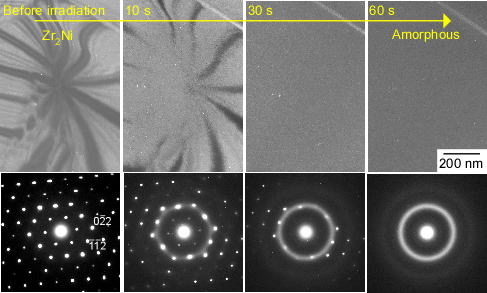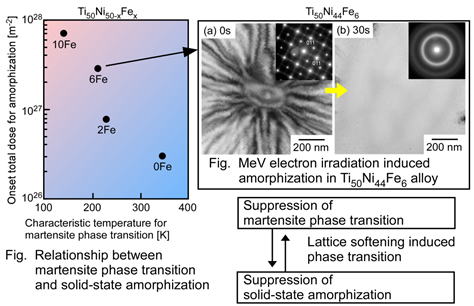| Irradiation induced Solid State Amorphization (SSA) |
| Irradiation induced Solid State Amorphization (SSA) |
![]()
Table 1 Amorphization tendency in intermetallic compounds under MeV electron irradiation. The experimental data on the occurrence of solid-state amorphization (crystal-to-amorphous transition) by MeV electron irradiation reported to date [1,2]. The experimental data list was firstly developed by H. Mori [3], and most of the data are taken from that list. (Updated on 12/25/2014).  REFERENCE [1] T. Nagase (Contribution): Advanced materials design by irradiation of high energy particles, in: Progress in Advanced Structural and Functional Materials Design, Ed., T. Kakeshita, Springer, 2013. pp. 137-153. ISBN 978-4-431-54063-2 http://www.springer.com/materials/structural+materials/book/978-4-431-54063-2 [2] T. Nagase, A. Nino and Y. Umakoshi:J. of alloys and compounds, 509, S202-S205 (2011). http://dx.doi.org/10.1016/j.jallcom.2010.12.051 [3] H. Mori, Current topics in amorphous materials, in: Y. Sakurai, Y. Hamakawa, T. Masumoto, K. Shirae, K. Suzuki (Eds.), Physics and Technology, Elsevier Science Publishers, Amsterdam, 1997, pp. 120–126. |
It is well known that MeV electron irradiation in HVEM can lead to solid-state amorphization (SSA) of intermetallic compounds. After first findings of MeV electron irradiation induced SSA [1-3], systematic experimental and theoretical studies on electron-irradiation-induced SSA have been conducted to understand the SSA mechanism [4,5]; The systematic experimental research clarified that this phenomenon was commonly observed for metallic materials [4]. It is proposed that the generalized Lindemann melting (GLM) criterion and theoretically suggested that SSA is a kinetically constrained melting process [5]. REFERENCE [1] H. Mori, H. Fujita, Jpn. J. Appl. Phys. 21 (1982) L494. [2] G. Thomas, H. Mori, H. Fujita, R. Sinclair, Scr. Metall. 16 (1982) 589. [3] A. Mogro-Campero, E.L. Hall, J.L. Walter, A.J. Ratkowski: in S.T. Picraux, W.J. Choyke (Eds.), Metastable Materials Formation by Ion-Implantation, North-Holland, New York, 1982, pp. 203–208. [4] H. Mori, Current topics in amorphous materials, in: Y. Sakurai, Y. Hamakawa, T. Masumoto, K. Shirae, K. Suzuki (Eds.), Physics and Technology, Elsevier Science Publishers, Amsterdam, 1997, pp. 120–126. [5] P.R. Okamoto, N.Q. Lam, L.E. Rehn, Physics of crystal-to-glass transformations, in: H. Ehrenreich, F. Spaepen (Eds.), Solid State Physics, vol. 52, Academic Press, San Diego, 1999. [6] T. Nagase, K. Takizawa, M. Nakamura, H. Mori and Y. Umakoshi: Journal of Physics: Conference Series 165, 012075-1 - 012075-6 (2009). http://dx.doi.org/10.1088/1742-6596/165/1/012075  Figure 1 Typical example of MeV electron irradiation induced solid state amorphization. C16-Zr2Ni, 2.0 MV, 103 K, 4.0x1024 m-2s-1 [6]. |
Both Solid State Amorphization (SSA) and Martensite (MS) Transformation are closely associated with lattice softening. This indicates that there is a close relationship between SSA and MS transformation. Generalized Lindemann Melting (GLM) Criterion implies the relationship between SSA and MS transformation from the theoretical view points. It has been reported that the amorphous volume fraction depends on the martensite transition temperature in binary Ti-Ni alloys undergoing plastic deformation [2], implying the relationship between SSA and MS transformation. However, there is no quantitative discussion about the relationship. High Voltage Electron Microscopy (HVEM) is suitable for clarifing the relationship in detail. Recently, it was reported that the stability of the B2 phase against martensite transformation monotonously increases with the Fe content in the Ti50Ni50-xFex alloy; the characteristic temperatures of martensite transformation, such as resistivity minimum, inflection point of resistivity, and susceptibility inflection point decrease with an increase in the Fe content [3]. To clarify the relationship between SSA and MS transition, electron irradiation induced SSA behavior in Ti50Ni50-xFex alloy is investigated by High Voltage Electron Microscopy (HVEM) [4]. REFERENCE [1] P.R. Okamoto, N.Q. Lam, L.E. Rehn, Physics of crystal-to-glass transformations, in: H. Ehrenreich, F. Spaepen (Eds.), Solid State Physics, vol. 52, Academic Press, San Diego, 1999. [2] J.C. Ewert , I. Bohm, R. Peter, F. Haidar: Acta Mater. 45, 2197 (1997). [3] M.S. Choi, T. Fukuda, T. Kakeshita. Scripta Mater., 53, 869 (2005). [4] T. Nagase, A. Sasaki, H. Y. Yasuda, H. Mori, T. Terai and T. Kakeshita: Intermetallics, 19, 1313-1318 (2011). http://dx.doi.org/10.1016/j.intermet.2011.04.013  Figure 1 Schematic illustration of the relationship between Solid-State Amorphization (SSA) and Martensite Transformation (MS) [4]. |